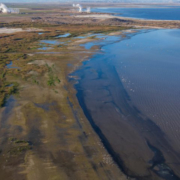The State of California, after resolving key hurdles, is set to move forward on a restoration project at the Salton Sea to improve habitat for migratory birds, while covering more exposed sea bed.
When the State Water Resources Control Board last met to discuss the status of the Salton Sea Management Program (SSMP), Chairman E. Joaquin Esquivel called upon the State to resolve issues causing delays in the State’s lead project at the sea—Species Conservation Habitat.
Resolution was reached on several of the issues in May, and now the state can move forward with a design-build plan for constructing the habitat project. Development of the project is a tangible sign of the Salton Sea Management Plan being implemented.
Wetlands project completed
Smaller-scale restoration projects at the Salton Sea are moving forward. California agencies, the Salton Sea Authority, and the Torres Martinez Desert Cahuilla Tribe completed a 60-acre wetlands project on the northern end of the sea. Additionally, work is advancing on the 500-plus acre Red Hill Marina wetlands project on the southeast side of the sea. Earthwork is complete, pipelines are in place, and pumps have been ordered and are on their way.
But, the Species Conservation Habitat project is the shining piece of phase one of California’s 10-year approach to the Salton Sea Management Program. It is a proof of concept project that would lay the groundwork for projects to come. The habitat project spans nearly 4,000 acres and entails building a series of ponds that would provide a controlled habitat to manage a fish population, which, in return, would provide a food source for migratory birds. Most importantly, it is a habitat project that would cover an expansive area of exposed playa.
Land issues resolved
What makes the Species Conservation Habitat project so critical is that it has already gone through the permitting phase for the entire 4,000 acres and is ready to move forward with construction. Those who follow the Salton Sea issues anticipated SCH would already be moving forward by now in a phased approach that would have seen about 640 acres completed first. However, an easement issue, lack of staff dedicated to the SSMP, and a learning curve associated with a design-build project delivery process – led to delays in the project.
With land issues resolved, the fact that California is increasing its staff dedicated to the Salton Sea and the Salton Sea Management Plan, and state agencies becoming more familiar with the design-build project delivery method, several obstacles impeding progress have been removed. The 4,000-acre project is expected to start this year be completed in 2023.
The State Water Resources Control Board will likely be holding a new workshop on the Salton Sea in the near future. By then, the State is to have a recovery plan as a path forward to prevent future delays in project development.



